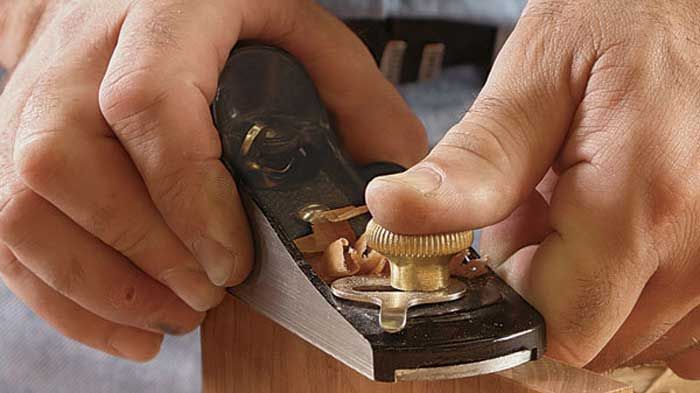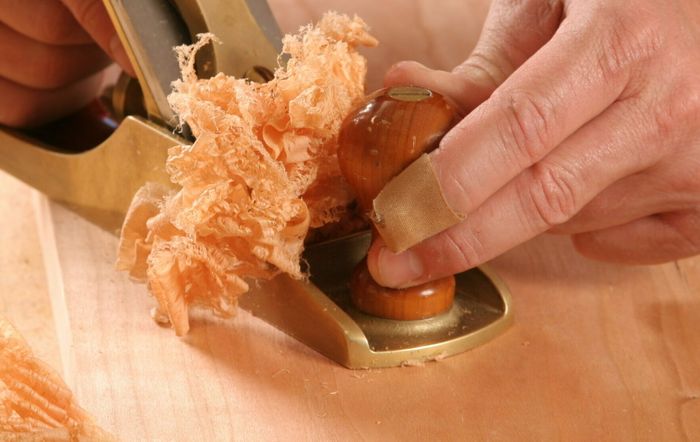Understanding Handplane Blade Angles
To get a smooth surface using handplanes, you sometimes need to change the angle of attack to overcome tricky grain.

It is no surprise that most woodworkers have limited knowledge of handplane blade angles: For most of the 20th century, little attention was paid to the link between the angle that the blade entered the wood and the resulting surface. The rule of thumb was to select a low angle (37º), bevel-up plane for end grain, and a standard pitch (45º), bevel-down plane for everything else. Correct to a point, but you’re missing a lot of capability.
While many factors determine a plane’s performance, including how well it is tuned, the depth of cut, and the size of the mouth’s opening, altering the angle at which the blade enters the wood, or the effective cutting angle (hereafter known as the cutting angle), can vastly expand the types of wood that you can handplane successfully.
As well as covering low- and high-angle planes that are available off the shelf, I’ll show you how you can modify existing planes and adjust the way you orient your plane to tackle difficult woods.
Think of the fibers
Before learning which type of plane to choose when faced with a challenging board, it helps to understand what happens when the blade enters the wood. Maximum smoothness, color, and clarity on a planed board are achieved when all the wood fibers fail (separate) right at the cutting edge. Defects occur when the fibers part away from the edge and instead fail along natural weaknesses in the wood.
These defects fall into two main categories based on the cutting angle and the type of wood.
Softer fibers tend to bend and stretch
A plane with a standard 45º cutting angle often poses problems for large-celled, more elastic softwoods and spalted woods. Considerable deformation of the wood can occur before the fibers separate. In some cases, the wood bends and stretches, piling up in front of the cutting edge, and then cyclically fails in a process called compression shearing. This leaves a rougher, often “fuzzy” texture as the surface goes through cycles of piling up and failing. In the worst case, the flexible, elastic fibers bend and stretch before the blade, then pull loose behind the blade edge, and usually well below it, leaving large irregular pits. This is most common in areas of poor integrity such as spalting. The solution is to use the lowest possible cutting angle so that the blade slices the wood while compressing it as little as possible.
Dense and highly figured woods break before they bend
For small-celled, dense, hard, rigid woods that deform little in the face of shearing forces, a very high cutting angle can leave a glass-smooth surface when a lower angle results in tearout.
On woods such as tiger maple, it is impossible to avoid planing against the grain. When planing at a low or medium cutting angle, the blade lifts the wood instead of slicing it, causing the wood to fail ahead of the blade, a failure known as diagonal splitting. Other such woods are those with reversing grain such as ribbon-stripe and dense, figured woods such as cocobolo. The solution is to use a much higher cutting angle. This causes less of a wedging action into the fibers and more of a shearing action; the shaving is more quickly turned upward by the steeper blade face behind the cutting edge, thus “breaking” the chip earlier.
Two ways to obtain low-angle cuts
Now that you know the angle to use, how do you obtain it? For a low-angle cut you can purchase a low-angle, bevel-up plane, or you can skew the plane relative to the workpiece.
Bevel-up planes achieve lowest-angle cuts
The principle feature that divides smoothing planes into two families is whether a plane is designed to support its blade with the primary bevel facing down or up. The former support the blade on a fixed bed or movable frog, most commonly angled at 45°. No matter what angle the blade is ground at, the bed/frog angle is the lowest cutting angle that plane can achieve.
Planes with the primary bevel facing up typically have a bed angle of 12°-20º. Combined with a blade angle that offers reasonable edge retention (a minimum of 20º on softwoods, 25º on hardwoods), this achieves a minimum effective cutting angle of 32° to 37º. By “edge retention,” I mean avoiding an edge that comes to such a point that it chips or otherwise deforms after minimal use. The usual term for these planes is low angle, but because they can be modified to cut at high angles, there is a move toward calling them bevel-up planes.
Lower the cutting angle by skewing the plane
So far the discussion has assumed that the plane travels only in a direction directly perpendicular to the blade’s cutting edge. When that direction is changed, called skewing the plane, the wood climbs the blade somewhat diagonally at what is known as the functional cutting angle. Thus, a plane with a 45º effective cutting angle, when skewed to 20º, develops a functional cutting angle of 42º. If the skew is increased to 45º, the wood will climb only a 30º slope.
This principle applies to any plane: A bevel-up plane with a 12º bed, the blade beveled at 20º and skewed at 60º, (the lower limits in all three parameters), has a functional cutting angle of a little over 15º.
Skewing can be a very useful means to maximize the versatility of a single plane, and allows you to adapt to changing characteristics of the wood surface without having to turn to another plane or a different blade geometry. One warning about skewing: Don’t counteract a deliberately high effective cutting angle by inadvertently skewing the plane during use—an easy thing to do when working a large surface.
Modify your plane to cut at high angles
For most bevel-down planes, the angle of the bed or frog is established by the manufacturer and cannot be modified easily. The exception is the Lie-Nielsen bench planes that can be retrofitted with a 50º frog, increasing the cutting angle by 5º.
A more versatile option is to bevel the back of the blade in addition to the main bevel on the face. A back bevel is typically very narrow because it must extend only slightly beyond the depth of the cut—for smoothing purposes, about 132 in.
The effective cutting angle is now the back bevel and the bed angles combined. So on a plane with a typical bed angle of 45º, a back bevel of 10º gives an effective cutting angle of 55º. A narrow back bevel can easily be ground away to return a blade to a flat back or to establish another back bevel angle; better still, have an extra blade or two on hand.
Because back bevels are so narrow and the angle is typically 10° to 20º, they can be hard to hone freehand, and most commercial honing guides are not designed to produce these smaller angles. The best solution is the Veritas Mk.II (www.leevalley.com), designed to produce bevels from 2º to over 54º.
Convert your bevel-up plane to a high-angle plane
Increasing the effective cutting angle on a bevel-up plane only requires altering the blade’s face bevel. Thus a plane with a 12º bed coupled with a blade beveled at 38º yields an effective cutting angle of 50º, while a bevel of 50º yields an effective cutting angle of 62º. Again, consider buying an extra blade or two. Lee Valley offers blades with different bevel angles for some bevel-up smoothing planes.
How best to increase your range of angles
If you are buying your first plane, consider a bevel-up one. The design allows a greater range of effective cutting angles (32° to 65º assuming a 12º bed) than the bevel-down design (45° to 65º assuming a 45º bed). On the other hand, if you already own a good-quality bevel-down plane, experiment with back bevels. If they work for you, buy an extra blade.
A well-tuned plane of either type will handle most boards, but when that special, highly figured board comes along and you are struggling to reveal it in all its glory, I hope this information assists you.
From Fine Woodworking #186
Fine Woodworking Recommended Products

Bahco 6-Inch Card Scraper

Suizan Japanese Pull Saw

Veritas Precision Square

-thumb1.jpg)






Comments
I hope that Lyn Mangiameli will retract that report that he has written about me. My children are being sexually abused. Dr. Mangiameli was paid to write a psychological report about me. Since an attorney had indicated that she would tamper with any report, I refused to meet with Dr. Mangiameli. He went ahead and wrote a report anyhow without using an empirically valid assessment.
In the report Dr. Mangiameli stated that I was "delusional" for trying to protect my kids. My eldest son had already confirmed the sexual abuse.
At the very least, Mangiameli had evidence that my youngest daughter was under the legal custody of a man who previously drugged and raped a teen. He even acknowledged seeing that evidence.
But all he cared about in the end was pocketing the money.
I hope that he changes his mind and retracts the report.
h
Log in or create an account to post a comment.
Sign up Log in